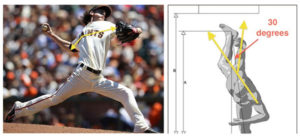 Separation-timing more accurate measurement of pitch velocity, WHAT IS THIS?
Separation-timing more accurate measurement of pitch velocity, WHAT IS THIS?
Just when you thought it couldn't get any better and it does!
If you know anything about 3X Pitching, you know the power of hip to shoulder separation. 3X Pitching is a comprehensive approach to high velocity pitching that teaches the enhancement of hip to shoulder separation through a linear force vector and an explosive triple extension (3X).
Hip to shoulder separation has been labeled as a way to measure the high velocity pitcher. The National Pitching Association in their studies of over 500+ pitchers have discovered that the average Major League Pitcher has 40-60 degrees of hip to shoulder separation.
How to Measure Hip to Shoulder Separation?
A rough way to measure this critical high velocity component is in video analysis. You need footage of the pitching delivery from the side angle so you can get a good perspective of the linear moves. The moment when you can more accurately measure the degrees of separation are first when the front leg lands and stabilizes at front foot strike. This is the moment the front knee is not moving forward anymore. You want to also make sure that the hips are open to the target or at the point of peak angular velocity. This means the point the hips are rotating at their top speed. Now you can start your measurements.
The rough estimate begins by changing the perspective. You need to visualize a birds-eye view of the pitcher at this point in the video and first draw a circle for the top of the head. Then draw a line through the left hip all the way through the right hip. Then draw a line through the left shoulder all the way through the right shoulder. View the picture here of David Robertson to get a better understanding of the analysis. Once you have these lines then you can connect your angles and guesstimate your degrees of separation using a right angle of 90 degrees to help. Like I said, it is a rough estimate.
The Ultimate Measurement of Separation and the High Velocity Pitcher
Knowing the degrees of hip to shoulder separation can give you a ballpark figure of the pitching velocity of the pitcher but it does not give you an accurate representation of pitching velocity. The point is the average Major League Pitcher was found to have around 40-60 degrees of hip to shoulder separation but is that enough to pin point the pitching velocity of these pitchers? No, but if you are a low velocity pitcher it gives you something to work for, but here is the kicker. The data is suggesting that a pitcher at 50 degrees could be throwing 90mph and a pitcher at 40 degrees could also be throwing 90mph. This example shows some discrepancy with the data. This means you could also be close to 40 degrees of hip to shoulder separation and topping out at only 84mph which is just short of high velocity. This is why we need more date to more accurately measure pitching velocity through a significant mechanical component like hip to shoulder separation. This is where separation-timing comes into play.
Three well respected medical professionals in the game of baseball have put together a document called, Baseball Pitching Biomechanics in Relation to Injury Risk and Performance. These well respect medical professionals are Dave Fortenbaugh, MS, Glenn S. Fleisig, PhD,* and the legendary James R. Andrews, MD. In the document they talk about the measurement of separation-timing and how it better defines the differences in the high velocity to low velocity pitcher.
If pitch cycle time is normalized such that 0% represents foot contact (FC) and 100% represents ball release (BR), the instant of peak pelvis rotation velocity is between 28% and 35%, and the instant of peak upper trunk rotation velocity is between 47% and 53%, with a separation of approximately 18% to 22%. Although Matsuo et al did not directly measure this separation timing, the high-velocity group had a separation-timing mean difference of 23%, whereas the low- velocity group had a mean difference of 17%. Stodden et al also found, when analyzing pitcher variations, that the pelvis orientation at the times of maximum shoulder external rotation (MER) and BR and the proper rotational velocities of the pelvis and upper trunk translated into higher ball velocities.
Read the entire publication here: http://www.ncbi.nlm.nih.gov/pmc/articles/PMC3445126/#bibr25-1941738109338546
This information is revolutionary because it upgrades the understanding of hip to shoulder separation by adding in the representation of speed. By stating that the pitcher took more time to peak the speeds of the trunk following the peak speeds of the hips gives the low velocity pitcher the understanding that degrees of separation are only effective when increased if it allows the pitcher to peak his trunk speeds closer to ball release. If the low velocity pitcher is getting average to above average degrees of hip to shoulder separation, something close to 40 degrees, but is not seeing high velocities then his mean difference of separation-timing could be low.
How to Measure Separation-Timing?
The problem with measuring separation-timing is 25 or 29 frames per second from a video analysis will not be enough information to measure much of a difference between the peak pelvis speeds and the peak trunk speeds. If by chance you can obtain a high speed camera that at least shoots more than 100-150 frames per second then this should give you enough information to work with.
Start with a side view like in the previous example of measuring separation. Count the amount of frames from front foot strike (FFS) to pitch release (PR). For the purpose of making this a simple process to follow lets say the amount of frames was 100 frames from FFS to PR. First find the frame where the hips completely open and the front foot stops moving forward and count back to FFS. Let's say for the purpose of this example the amount of frames is 28 which would represent 28% of the entire movement from FFS to PR. Now let's find the frame where the trunk or shoulders are completely open to the target or the moment the trunk speeds are at their peak. From this frame count back to FFS. Let's say for the purpose of this example that it is 47 frames which would represent 47% of the total movement from FFS to PR. This means the separation-timing difference is 19% which is in the high velocity group of the studies listed above. I get 19% by subtracting 28% from 47%.
You can see after following this simple example of measuring separation-timing that it tells a lot more about the development of pitching velocity of the pitcher. It is a more difficult measurement to obtain but it is a more valuable measurement to understanding the pitcher.
Separation-Timing Reduces Arm Torque
The document above also found an eye opening discovery which was that professional pitchers had less torque in their shoulders than college, high school and even youth pitchers during internal rotation. They hypothesized that this was due to a more efficient timing of the pelvis to trunk rotation but then found no significant difference in the timing of these groups. The only differences they did find was the separation-timing factor defined above. The professional and college pitcher had a larger margin between the pelvis peak speed to the trunk peak speed. This leads you to believe that professional pitchers do not use more "Arm Strength" to generate velocity but a larger difference in separation-timing or they are reaching their peak trunk rotation speeds closer to pitch release. This would make perfect sense because Newton's Second law of motion proves that to increase acceleration of an object, you must increase the force applied or the application time when applying the same amount of force. A larger difference in separation-timing would increase the application time without losing force. Here is the excerpt from the document listed above that explains this discovery.
Aguinaldo et al showed that professional pitchers generated significantly less normalized shoulder internal rotation torque than that of college, high school, and youth pitchers. The researchers hypothesized that the professional pitchers were able to maximize their efficiency by rotating their upper trunks at the appropriate time, allowing the energy to pass from the trunk to the shoulder at precisely the right sequence. Although both pathomechanical patterns (pelvis and upper trunk rotation) make intuitive sense, Fleisig et al did not find significant differences in the timing of the maximum pelvis or upper trunk rotation velocity. However, there were clinically significant separation timing differences between pelvis and upper trunk rotation: 11% and 12% in youth and high school pitchers, 17% and 18% in college and professional pitchers.
Dr. Mike Marshall, well known out of the box pitching instructor - way out of the box, used Newtons formula of a = F/m, from Newton's Second law of Motion, to determine how much force to apply to the baseball along with how long to apply this force to throw 90mph. Dr. Marshall found that 6.6 pounds of pressure applied to a 5 ounce baseball for .20 seconds = 90 mph fastball. This helps us understand how separation-timing effects ball speed. The higher velocity pitchers on average go from maximum external rotation (MER) to PR in less than .20 of a second. I am using MER as the first movement because that is when force is first applied to the ball in the throwing motion. Aroldis Chapman actually does this in less than .10 of a second. This means it would be more accurate to use .10 of a second within Newton's formula. Replacing .10 for .20 doubles the force applied to reach 90mph. For those math geeks who want to see the formula here it is from Dr. Mike Marshall with .20 and 90mph (source: http://www.drmikemarshall.com/ChapterTwenty-Nine.html).
- Formula: a = F/m
- Multiple both sides by mass (m): (m)(a) = (F)(m)/(m)
- Because (m)/(m) = 1: (m)(a) = F
- Substitute (0.01) for mass: (0.01)(a) = F
- Substitute (vr) / (t) for a: (0.01) (vr)/(t) = F
- Multiply both sides by time (t): (0.01)(vr)(t)/(t) = F(t)
- Because (t)/(t) = 1: (0.01)(vr) = F(t)
- Divide both sides by (0.01): (0.01)(vr)/(0.01) = F(t) / (0.01)
- Because (0.01)/(0.01) = 1: (vr = F(t)/(0.01)
- Release Velocity Formula: (vr) = (F)(t)/(0.01)
- 90 mph equals 132 ft/sec
- Substitute known quantities: (132) = (F)(0.2)/(0.01)
- Divide both sides by (0.2): (132)/(0.2) = (F)(0.2)/(0.2) / (0.01)
- Because (0.2)/(0.2) = 1: 660 = (F)/(0.01)
- Multiply both sides by (0.01): (660)(0.01) = (F)(0.01)/(0.01)
- Because (0.01)/(0.01) = 1: 6.6 = F
- Change sides: F = 6.6 lbs.
Here is the formula calculating .10 second and 90mph.
- Because (0.01)/(0.01) = 1: (vr = F(t)/(0.01)
- Release Velocity Formula: (vr) = (F)(t)/(0.01)
- Substitute known quantities: (132) = (F)(0.1)/(0.01)
- Divide both sides by (0.1): (132)/(0.1) = (F)(0.1)/(0.1) / (0.01)
- Because (0.1)/(0.1) = 1: 1320 = (F)/(0.01)
- Multiply both sides by (0.01): (1320)(0.01) = (F)(0.01)/(0.01)
- Because (0.01)/(0.01) = 1: 13.2 = F
- Change sides: F = 13.2 lbs.
This means the pitcher would have to apply 13.2 lbs of pressure for .10 of a second to throw 90mph. Most low velocity pitchers may be applying 13.2 lbs to the throwing arm but are doing it even in a shorter amount of time. For example, most studies show that low velocity pitchers get less external rotation than high velocity pitchers. This will mean they are using less time to apply force to the ball. Studies show more degrees of hip to shoulder separation helps the pitcher to get more shoulder abduction which allows for maximum external rotation. This increased external rotation allows the pitcher to apply more application time as illustrated in the animated clip here of Chapman and a youth pitcher.
The lesson here is do not just get caught up in the positions of the mechanics. Just because you can style your delivery like Tim Lincecum doesn't mean you are moving as explosive as him. The bread and butter of the high velocity pitcher always lives in the speeds and timing of these complex movements.




Trackbacks/Pingbacks